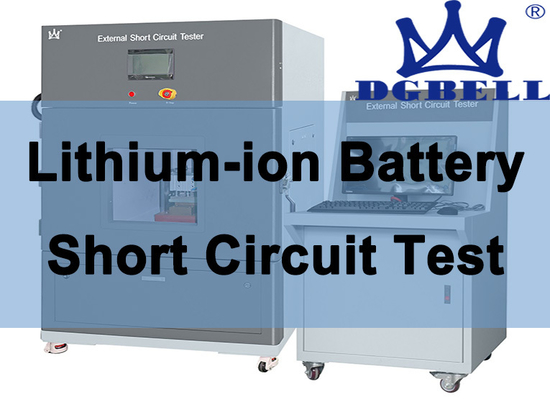
#Industry News
EV Power Battery Environmental and Safety Test – Part 2
EV Power Battery Environmental and Safety Test – Part 2
c) Short circuit test
Lithium ion batteries are stored in an explosion-proof chamber at room temperature (20 ± 5) ℃. When the lithium-ion battery is short circuited externally, the external circuit resistance should be less than 5 mΩ. During the test, the lithium-ion battery should not explode or catch fire. Through experimentation. The battery did not explode or catch fire. This test is to assess the performance of lithium-ion batteries during normal use or accidents. There may be a short circuit between the positive and negative terminals of the battery, which can generate a large amount of current. At this point, the internal protection circuit of the battery should work and disconnect the electrodes. Ensure that the battery does not explode or catch fire.
d) Drop test
Lithium ion batteries are operated at (20 ± 5) ℃. Falling from a height of 1.5 meters from the south onto a hardwood floor with a thickness of 20 mm. Each side undergoes one drop test (the battery referred to here is a rectangular shape, so it needs to go through six drop tests) during the test. Lithium ion batteries should not explode, catch fire, or leak liquid.
e) Heating test
Place the lithium-ion battery in a constant temperature chamber. And maintain the temperature unchanged for 120 minutes. During the experiment, lithium-ion batteries should not explode or catch fire.
Electric vehicles are driven for long periods of time under scorching sun exposure. Place the power battery in a closed space. The temperature of its working environment can reach over 60 ℃. If lithium-ion batteries cannot withstand tests used in high-temperature environments. Explosion and fire will occur. This experiment is to assess the safety performance of power batteries in high-temperature environments.
f) Squeeze test
Place the lithium-ion battery in a compression test chamber. Apply pressure in the direction perpendicular to the battery plate, with a compression area of no less than 20 cmz. Squeeze until the battery casing ruptures or there is an internal short circuit (the battery voltage becomes 0 V). This test is a destructive test. During the test, lithium-ion batteries should not explode or catch fire.
If an electric vehicle experiences an accident while driving. Especially when the part where the power battery is placed in an electric vehicle is hit by another vehicle. The outer shell of the power battery may break. Even the power battery may be shattered, leading to explosions and fires.
g) Acupuncture test
Lithium ion batteries are placed in explosion-proof needle puncture test chambers. Use high-temperature resistant steel needles with a diameter of 3-8 mm. At a speed of 10-40 mm/s. Through the direction perpendicular to the battery plate (the steel needle stays in the battery), the battery is maintained in a short circuit state through the penetration of the steel needle. During the test, lithium-ion batteries should not explode or catch fire
Most of the components of a car are made of metal, especially in the event of an electric vehicle accident or accident. After the power battery was hit. There may be metal parts piercing or even penetrating the power battery. Causing battery short circuit, internal electrolyte leakage, smoking, and battery breakage. The needle puncture test and compression test are both used to assess the safety performance of power batteries in the event of accidents.
The above is the safety performance verification of individual lithium-ion batteries, but of course, the safety performance of individual batteries cannot fully represent the safety performance of the overall battery pack. This is because individual differences exist in individual batteries themselves. When forming a battery pack, the dynamic consistency level of a single battery will not be reached, and this situation will lead to the instability of the battery pack. It may even affect its service life. So after combining individual batteries into battery modules. The above safety performance test should be repeated.
We should also know. The safety of lithium-ion batteries is not only affected by the above aspects. Due to the different requirements for the overall design of electric vehicles and the process design of batteries themselves. It will cause the position of the battery on the car to be different. It can be divided into centralized layout or decentralized layout, each with its own advantages and disadvantages. So when arranging the position of the battery, it is necessary to consider the actual space situation inside the car: if we want to achieve a compact layout. It is necessary to change the traditional installation method of electric vehicle batteries; Of course. The safety of the battery should also be considered. To further achieve a perfect combination of vehicle design and battery system matching design.
3 Conclusion
The usage characteristics of power batteries in electric vehicles are incomparable to other power sources and batteries. Due to the use of automobiles, their location, and various situations that may occur, batteries are prone to high-speed movement, severe vibration, high-temperature operation, rapid charging and discharging, potential impacts, punctures, as well as short circuits, falls, immersion, fire, and even gunshots. Therefore. Electric vehicles have extremely high safety requirements for power batteries. A small non safety probability can cause extremely serious consequences to the battery.
In summary. Today, the application of power batteries will become increasingly widespread. Improving the safety performance of power batteries will be a permanent topic regarding power batteries.







